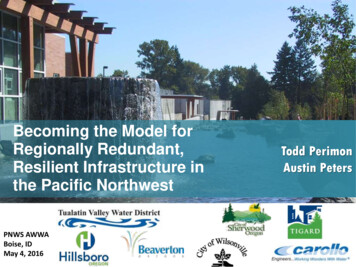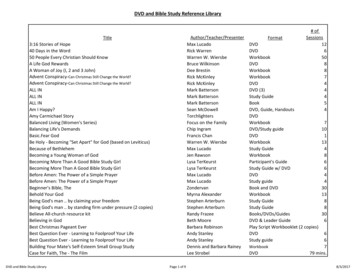
Transcription
Becoming the Model forRegionally Redundant,Resilient Infrastructure inthe Pacific NorthwestPNWS AWWABoise, IDMay 4, 2016Todd PerimonAustin Peters
Agenda Overview of the WWSP Defining Resiliency &Redundancy Developing the Master Plan Building Consensus Conclusions
What is the Willamette Water SupplyProgram? (WWSP) Regional water supply program for developing newtreatment, storage and conveyance infrastructurefrom the Willamette River. Partnership between TVWD and the City of Hillsboro The Cities of Beaverton, Tigard, Tualatin areconsidering their options for participation Wilsonville and Sherwood are currently using theexisting WRWTP
WWSP OverviewWestern ExtensionsEastern Extension30 MG TerminalStorage66-in DiameterMain Stem PipelineExisting WRWTP,Intake and RWPump Station
The Long Road to a Regional Water WRWTPPilot Study1993 19941994-2002Willamette RiverWater SupplyAgency(IncludingTigard) RiverWater QualityMonitoringProgram1997-1998WillametteRiver urcesManagementStrategy19972008-2011TBWSP FinalEIS andOperationsPlanning2000IGA BetweenTVWD andWilsonville forConstruction ofWRWTP1999 20001999-2000WRWTP PilotStudy(Actiflo/HighRate Filtration)2000-2002WRWTP D/BConstruction2002-2004Tualatin BasinWater SourceWaterAssessment2006WRWTP 2006Master Plan20042006 2007 20082004-2007TualatinBasin WaterSupplyProject(TBWSP)DraftPlanningReport andEIS2007-2008TBWSPDrought 2010-2011TBWSP IntakePredesign20102013Formalize theWillametteWater SupplyPartnership(WWSP)
The Long Road to a Regional Water Supply2026WillametteWater SupplyOnline andOperational2015WRWTPMaster PlanUpdate201520202015 - 2025Design and Construct Water Treatment Plantand Interconnecting Pipelines(multiple projects)2025
Defining Resiliency andRedundancy for theMaster Plan
Traditional Philosophy for Planning/DesigningTreatment InfrastructureFINANCIALCOST EFFECTIVETREATMENTPROCESSRELIABLY MEETPUBLIC ROTECT PUBLICHEALTHThis is classic “Triple Bottom Line” Analysis
Defining Resiliency through Level ofService
Regional Redundancy
A Regional approachto RedundancyWTPReservoirASRWell FieldResilient Element
Water Quality andQuantity
Oregonians are Concerned about WaterQualityLocal environmental issue most concerned aboutThe quality of your drinking water28%22%The health of local rivers, streams and lakes19%Climate change15%The air quality in your communityThe health of area forestsContamination of land and soilOregon statewide9%8%
Projecting Regional Water Demands120WRWTP Max Day Flow igard8065 MGDDemand in 202660Existing capacity of15 mgd in operationsince 2002402002014201820222026203020342038204220462050
Anticipating Future Water TreatmentPlant ExpansionsSite BuildoutFutureExpansionInitial Expansion
Seismic Design Criteria:Anticipating the Cascadia Subduction Zone EventPreparing for theWorst
Develop Preliminary LOS GoalStatement: “Following a W catastrophic event within X days/weeks of the event delivery Y % of average day demand with Z water quality .”
Developing Level of Service GoalsLOS Goal:Regional Event(Seismic) Defined 2 distinct categories of disasters Identified unique LOS criteria for each eventLocal Event(Non-Seismic)
Developing Level of Service GoalsLOS Goal:Catastrophic eventAcceptable delayfollowing eventSupply goalWater quality goalRegional Event(Seismic)2,500 yearLocal Event(Non-Seismic)per occurrence48 hours14 days50% of nameplatepotable (@ minimumregulatory requirement)100% of nameplatepotable (@ plantdesign criteria)
Converting Theoryinto an ActionableMaster Plan
A sequence of 8 workshops developed thedraft ect UncertaintyRecommendations Recommendations gies4.InfrastructureRecommendations Recommendations Recommendations ternativesEvaluationPlanFinalization
WS#1: Existing Site PlanExistingSite
Existing WRWTP FacilitySolidsDewateringSolidsThickeningRaw Water Intakeand Pump StationExistingSiteFiltersChemicalStorageClearwell &Finished WaterPump StationsOzoneBallastedFlocculationAdministration& Lab
WS#2: Existing WRWTP process designincorporates multi-barrier approach Turbidity / Particles Pathogens Tastes and Odors Trace TreatmentProcess
TreatmentProcessTechnical Advisory committeerecommended treatment process Existing Process planning for AOP/Enhanced BiofiltrationPhosphate/NutrientsFuture UVActiflo OzoneH2O2FiltersClearwellH2O2
TreatmentProcessTreating UCMR-3 CompoundsEffectiveness Treating Compounds Listed Under UCMR-3Existing neGACAdsorptionBiofiltrationChlorinationTreatment Enhancements with Low Cost Plant UpgradesOzone ruses
TreatmentProcessTreating Other ContaminantsCurrently Making HeadlinesEffectiveness Treating Other Contaminants of InterestExistingProcessesTreatmentProcessAlgal ToxinsEndocrineDisruptorsPhACsPCPsN. orptionBiofiltrationChlorinationTreatment Improvements with Low Cost Plant UpgradesOzone tibioticResistantGenes
Alternative Treatment ProceduresActiflo Capacity(mgd/train)Alternative A (Baseline)OzoneCrypto Disinfection(1-log)7.5 treatment proceduresYesMaintain ter)5.0Increase capacity10 of existing processesYes maintaining 1-log6.7of CryptoAlternative C (SDWA Only) inactivationT&O Only7.9Safe Drinking15Water Act ComplianceAlternative B (Modified)
WS#3: Utilization of The Existing WRWTP:Alternative operational strategiesOperationalStrategiesAlt 1:2 Plants, 2 OperatorsAlt 2:2 Plants, 1 OperatorAlt 3:1 Plant, 1 Operator
Combining operational andprocedural alternativesCombinedAlternatives
WS#4: Maximizing existing infrastructureto minimize new constructionInfrastructureThe existing raw water intake was modeled to determine if additionalcapacity could be achieved without the need for a new intake
WS#5: Defining Site ConstraintsPermitting Existing Right-ofWays Riparian buffers Maintaining greenspace Being a goodneighbor
WS#6: Visualizing the new plantAPPROACHSiteUtilization
WS#6: Visualizing the new plant
WS#7: Evaluating AlternativesAlternativesEvaluationTreatment ProceduresOperational StrategiesEarly meetings with the technical advisory committeeand agency stakeholders confirmed the treatmentprocess approach
WS#7: Evaluating AlternativesAlternativesEvaluationTreatment ProceduresOperational StrategiesAll scenarios are feasible (constructible, meet seismic criteria);All scenarios meet quality and quantity criteria;All scenarios provide a similar level of redundancy
WS#8: Evaluation Criteria Economic Criteria Operational flexibility Flexibility to addressfuture regulations Space requirements Permitting requirements Constructability Community impactsAlternativesEvaluation
Enhanced Decision Making Process Individual meetings with partner and potential partneragencies Incorporate technical advisory committeerecommendations Coordination with the Willamette Governance Group Engage elected officials
What’s Next for the Master PlanUpdate Level ofService Goals Backup power Seismicperformance System storage Alternativesources ofsupplySelection ofPreferredExpansionAlternative Treatmenttechnology Facility Layout OperationalStrategiesBuildingConsensus Enhanced DecisionMaking Process
Conclusions Maintaining stakeholder support though projectcompletion requires communication,collaboration, and transparency. The standard approach to resiliency provides avaluable framework to start with, but resilientsolutions are uniquely tailored to each project. Achieving resiliency and redundancy (LOS) goalsstarts with a good plan and a firm basis forevaluating and selecting preferred alternatives
THANK ACHMOBILIZATIONTEAM Q&AWillamette Water Supply Program
Alternative Treatment Procedures Capacity (mgd/train) Crypto Disinfection (1-log) Capacity (mgd/filter) Alternative A (Baseline) 7.5 Yes 5.0 Alternative B (Modified) 10 Yes 6.7 Alternative C (SDWA Only) 15 T&O Only 7.9 Actiflo Ozone Filters Safe Drinking Water Act Complianc










